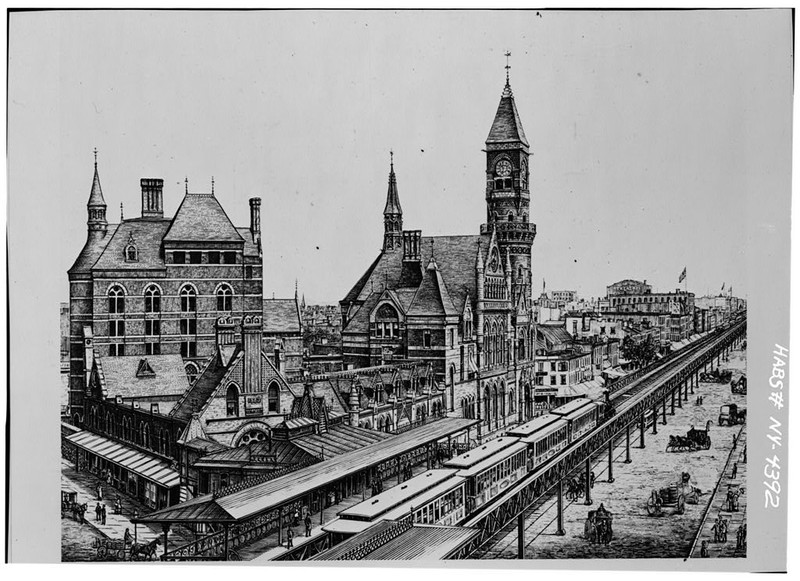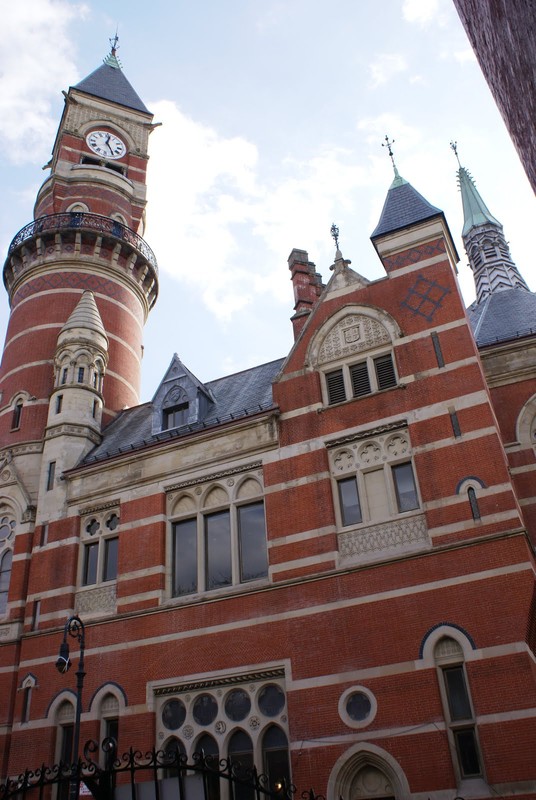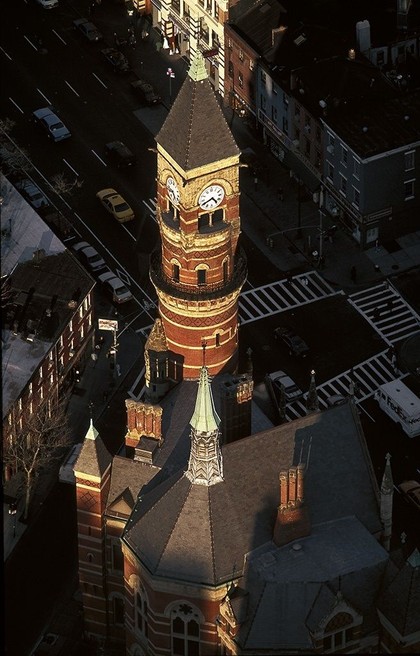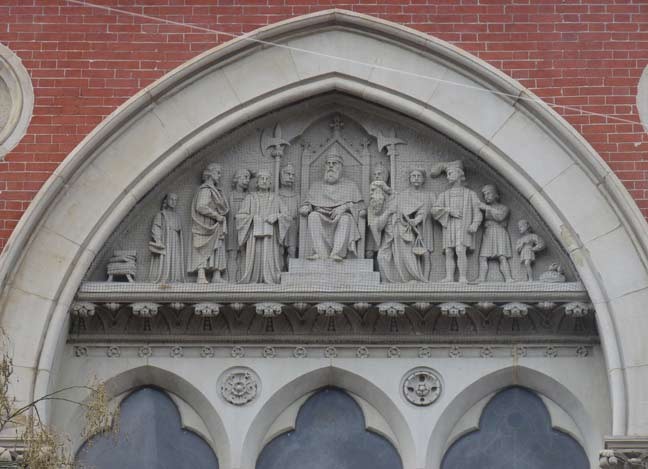Jefferson Market Library (formerly Third District Judicial Courthouse)
Introduction
Text-to-speech Audio
The Jefferson Market Library (formerly the Third District Judicial Courthouse) is located in New York City's Greenwich Village, on a triangle of land bounded by Sixth Avenue to the east and 10th Street to the northwest. The area was originally a local market established in the early 1830’s shortly after the death of Thomas Jefferson, and named after him. A new courthouse, built in the Victorian Gothic (or Venetian Gothic) style, as well as a new prison and market, were constructed on the location during the years 1874-1877 by the architectural firm of Withers and Vaux (the old courthouse building is all that remains). It was voted fifth among the ten most beautiful buildings in America by a poll of architects in the 1880s.
The building was vacated in 1958 and marked for demolition, but preservationists rallied to save it. In 1961, the city announced that the old courthouse would be converted into a library, and it was opened as the Jefferson Market branch of the New York Public Library in 1967. In 1972, the building was placed on the National Register of Historic Places.
Images
The Third District Judicial Courthouse ca. 1880 (New York Historical Society, via the Library of Congress)

Jefferson Market Library today (ground view)

Jefferson Market Library (aerial view)

Jefferson Market pediment, depicting a scene from Shakespeare's The Merchant of Venice

Backstory and Context
Text-to-speech Audio
By the mid-19th Century, the area around Jefferson Market in Greenwich Village had become associated, in the
minds of respectable people, with "everything that is bad, mean and unsavory." A plan for a new courthouse in the area was first
proposed in the early 1870s and approved by the notorious New York political machine of “Boss”
Tweed. When over $150,000 was spent with nothing to show, the original design
was scrapped and the firm of Withers and Vaux was hired to create a new design.
Although credited to both English-born Frederick Clarke Withers and Calvert Vaux - the latter is famous for co-designing Central Park with Frederick Olmstead - the courthouse, as well as the then-adjacent prison, were designed solely by Withers in the Victorian Gothic style, inspired by the English writer John Ruskin, and it is considered his best-known work. The project was highly controversial: citizen protests and contract disputes marked its construction. However, the final cost of not only the courthouse, but all of the complex’ buildings, was less than $360,000 – quite a bargain, since the estimated cost for the original (unused) design ran to millions of dollars!
The building originally included a police court, which later served as a night court, on the ground floor and a district court on the second floor. Harry K. Thaw, the infamous killer of architect Stanford White, was arraigned and imprisoned there in 1906. In 1909, striking female workers from the Triangle Shirtwaist Factory were arrested and taken to the night court there. This was to humiliate the proper young ladies: during this era, prostitutes were frequently brought into night court. (Two years later, many young women in that same factory would die in a notorious and horrific fire.)
Due to redistricting, the building stopped being used as a courthouse in 1945, and for over a decade thereafter it was employed for many purposes, including as a police academy. After the building was abandoned in 1958, many local people of prominence, including the preservationist Margot Gayle, the historian Lewis Mumford, poet e.e. cummings and actor Maurice Evans banded together to save first the clock tower, then the building itself. In 1961, New York City Mayor Robert Wagner announced that the building would be converted into a library. Architect Giorgio Cavaglieri was hired in 1965 to completely convert the abandoned building, and he accomplished the task in only two years.
The library has a children’s reading room where the police court used to be, and an adult reading room where the district court once was. A reference library, which contains many volumes (some rare) on the history of New York, is located in the basement. The exterior is faced in red brick with Black brick and yellow sandstone trim; its cornice and frieze are made of granite. At the northeast corner is a tower with an iron balcony and pyramidal roof, with a prominent four-faced clock at the top. The structure contains many gables and stained-glass windows. The tympanum above the library’s entryway contains a bas-relief sculpture representing the climactic courtroom scene in Shakespeare’s The Merchant of Venice. In 1996, the old fire bell in the tower rang for the first time in over a century.
Although credited to both English-born Frederick Clarke Withers and Calvert Vaux - the latter is famous for co-designing Central Park with Frederick Olmstead - the courthouse, as well as the then-adjacent prison, were designed solely by Withers in the Victorian Gothic style, inspired by the English writer John Ruskin, and it is considered his best-known work. The project was highly controversial: citizen protests and contract disputes marked its construction. However, the final cost of not only the courthouse, but all of the complex’ buildings, was less than $360,000 – quite a bargain, since the estimated cost for the original (unused) design ran to millions of dollars!
The building originally included a police court, which later served as a night court, on the ground floor and a district court on the second floor. Harry K. Thaw, the infamous killer of architect Stanford White, was arraigned and imprisoned there in 1906. In 1909, striking female workers from the Triangle Shirtwaist Factory were arrested and taken to the night court there. This was to humiliate the proper young ladies: during this era, prostitutes were frequently brought into night court. (Two years later, many young women in that same factory would die in a notorious and horrific fire.)
Due to redistricting, the building stopped being used as a courthouse in 1945, and for over a decade thereafter it was employed for many purposes, including as a police academy. After the building was abandoned in 1958, many local people of prominence, including the preservationist Margot Gayle, the historian Lewis Mumford, poet e.e. cummings and actor Maurice Evans banded together to save first the clock tower, then the building itself. In 1961, New York City Mayor Robert Wagner announced that the building would be converted into a library. Architect Giorgio Cavaglieri was hired in 1965 to completely convert the abandoned building, and he accomplished the task in only two years.
The library has a children’s reading room where the police court used to be, and an adult reading room where the district court once was. A reference library, which contains many volumes (some rare) on the history of New York, is located in the basement. The exterior is faced in red brick with Black brick and yellow sandstone trim; its cornice and frieze are made of granite. At the northeast corner is a tower with an iron balcony and pyramidal roof, with a prominent four-faced clock at the top. The structure contains many gables and stained-glass windows. The tympanum above the library’s entryway contains a bas-relief sculpture representing the climactic courtroom scene in Shakespeare’s The Merchant of Venice. In 1996, the old fire bell in the tower rang for the first time in over a century.
Sources
http://www.nypl.org/about/locations/jefferson-market
http://www.newyorkitecture.com/jefferson-market-courthouse
http://focus.nps.gov/GetAsset?assetID=646f0e23-b7b8-4047-94a4-cdf8f02d68f7 [PDF document]
http://www.neighborhoodpreservationcenter.org/db/bb_files/1969-greenwichvillageHDvol1.pdf [PDF document, pp. 183-184]
http://www.nypap.org/content/jefferson-market-courthouse
http://adaptivereuse.info/portfolio/jefferson-market-library
https://walkaboutny.com/2015/04/23/finding-shakespeare-in-surprising-places
